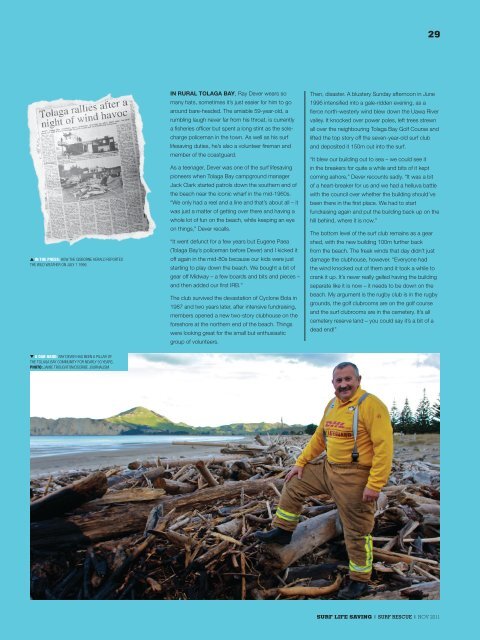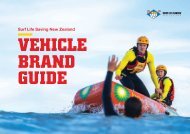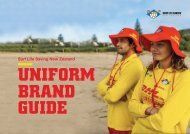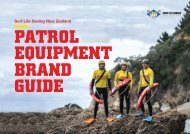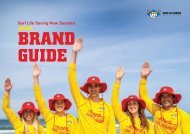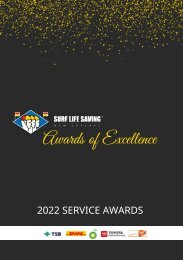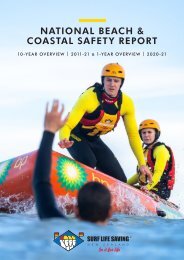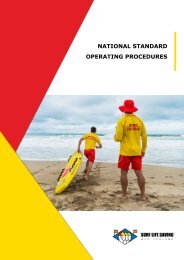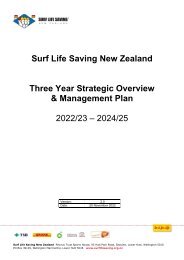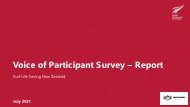2011_SLSNZ_SurfRescueMag
Create successful ePaper yourself
Turn your PDF publications into a flip-book with our unique Google optimized e-Paper software.
29<br />
IN THE PRESS: HOW THE GISBORNE HERALD REPORTED<br />
THE WILD WEATHER ON JULY 1 1996.<br />
IN RURAL TOLAGA BAY, Ray Dever wears so<br />
many hats, sometimes it’s just easier for him to go<br />
around bare-headed. The amiable 59-year-old, a<br />
rumbling laugh never far from his throat, is currently<br />
a fisheries officer but spent a long stint as the solecharge<br />
policeman in the town. As well as his surf<br />
lifesaving duties, he’s also a volunteer fireman and<br />
member of the coastguard.<br />
As a teenager, Dever was one of the surf lifesaving<br />
pioneers when Tolaga Bay campground manager<br />
Jack Clark started patrols down the southern end of<br />
the beach near the iconic wharf in the mid-1960s.<br />
“We only had a reel and a line and that’s about all – it<br />
was just a matter of getting over there and having a<br />
whole lot of fun on the beach, while keeping an eye<br />
on things,” Dever recalls.<br />
“It went defunct for a few years but Eugene Paea<br />
(Tolaga Bay’s policeman before Dever) and I kicked it<br />
off again in the mid-80s because our kids were just<br />
starting to play down the beach. We bought a bit of<br />
gear off Midway – a few boards and bits and pieces –<br />
and then added our first IRB.”<br />
The club survived the devastation of Cyclone Bola in<br />
1987 and two years later, after intensive fundraising,<br />
members opened a new two-story clubhouse on the<br />
foreshore at the northern end of the beach. Things<br />
were looking great for the small but enthusiastic<br />
group of volunteers.<br />
Then, disaster. A blustery Sunday afternoon in June<br />
1996 intensified into a gale-ridden evening, as a<br />
fierce north-westerly wind blew down the Uawa River<br />
valley. It knocked over power poles, left trees strewn<br />
all over the neighbouring Tolaga Bay Golf Course and<br />
lifted the top story off the seven-year-old surf club<br />
and deposited it 150m out into the surf.<br />
“It blew our building out to sea – we could see it<br />
in the breakers for quite a while and bits of it kept<br />
coming ashore,” Dever recounts sadly. “It was a bit<br />
of a heart-breaker for us and we had a helluva battle<br />
with the council over whether the building should’ve<br />
been there in the first place. We had to start<br />
fundraising again and put the building back up on the<br />
hill behind, where it is now.”<br />
The bottom level of the surf club remains as a gear<br />
shed, with the new building 100m further back<br />
from the beach. The freak winds that day didn’t just<br />
damage the clubhouse, however. “Everyone had<br />
the wind knocked out of them and it took a while to<br />
crank it up. It’s never really gelled having the building<br />
separate like it is now – it needs to be down on the<br />
beach. My argument is the rugby club is in the rugby<br />
grounds, the golf clubrooms are on the golf course<br />
and the surf clubrooms are in the cemetery. It’s all<br />
cemetery reserve land – you could say it’s a bit of a<br />
dead end!”<br />
A DAB HAND: RAY DEVER HAS BEEN A PILLAR OF<br />
THE TOLAGA BAY COMMUNITY FOR NEARLY 50 YEARS.<br />
PHOTO: JAMIE TROUGHTON/DSCRIBE JOURNALISM<br />
SURF LIFE SAVING | SURF RESCUE | NOV <strong>2011</strong>


